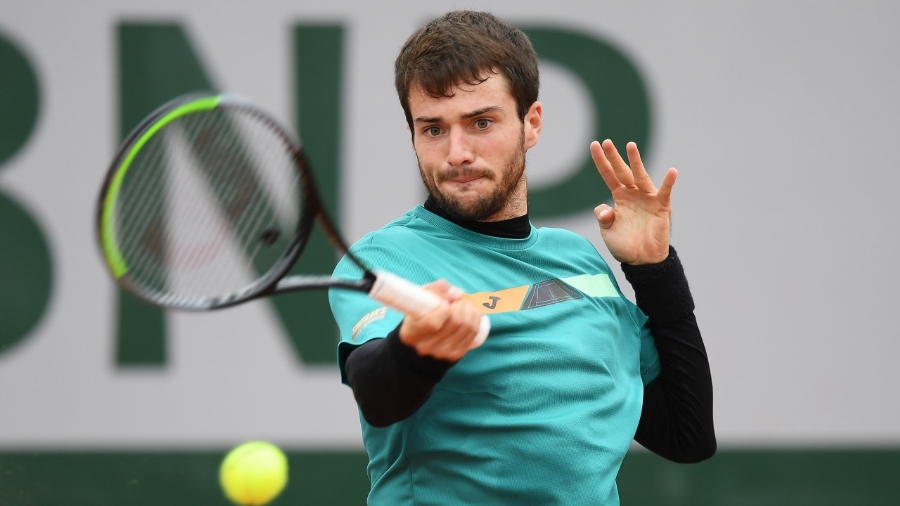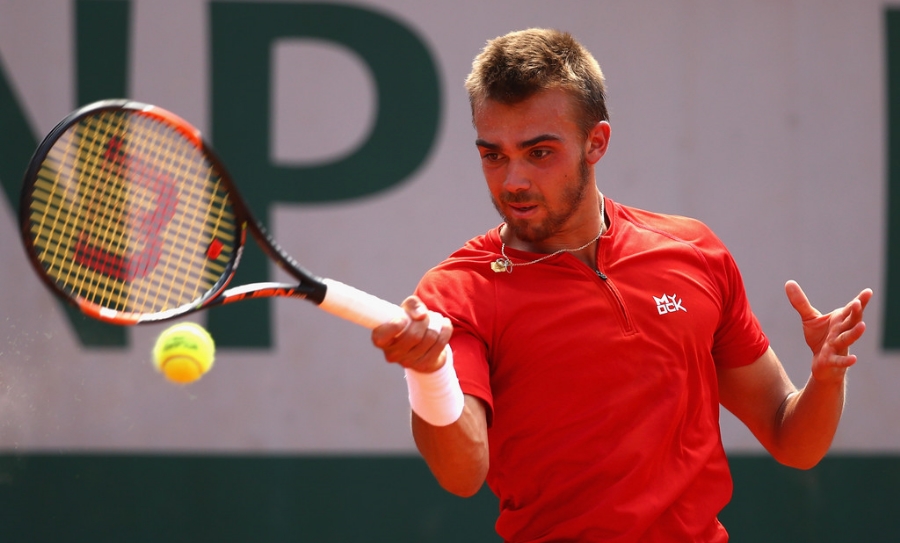Fortune favors the brave is the best fitting motto if you wanted to summarize what took place between Pedro Martinez and Emil Ruusuvuori, ranked right next to each other at 87 and 86 respectively, on Court 13 at the Australian Open in their second-round match on Tuesday. Martinez was aiming for the second time to reach the third round at a Major (first at 2020 Roland Garros) and Ruusuvuori was at his second attempt (first at US Open 2020) to get there for the first time in his career (first at 2020 US Open).
The match began in the scenario that the 21-year-old Finnish player would have written if he had the option. Engaging Martinez in extended cross-court rallies, working the middle of the court at times, baiting Martinez to go for winners from two or three meters behind the baseline, were patterns that favored Ruusuvuori who is perfectly comfortable with the notion of relying on sheer consistency from the backcourt, à-la Swedish school of the 80s (minus Anders Jarryd and Stefan Edberg).
It worked. Like clockwork.
And if you are an admirer of Ruusuvuori’s game like me, you enjoyed watching his impeccable timing on groundstrokes combine with his footwork, to showcase some impressive baseline execution.
Unfortunately for him, it only lasted for one set, but more on that later.
Ruusuvuori outclassed Martinez in the overwhelming majority of baseline rallies, with the Spaniard committing errors not because he was going for too much too early, but rather because he was simply not matching his opponent’s consistency. That trend reflected in the first-set stats, with Pedro scoring a mere 6 winners from his groundstrokes while attacking the net only twice. He also committed 12 unforced errors in 7 games, double the amount of that committed by his opponent. Ruusuvuori grabbed the first set 6-1 after 34 minutes.
Side note:
An area of future improvement for Ruusuvuori, one that I already noted in my previous match report involving him at Roland Garros 2020, is his reluctance to venture up to the net even when he has a clear opportunity to do so (read: even when his positioning on the court points to it being the best option). For those who enjoy visual examples, put the replay to the 30-30 point at the 2-0 game in the first set for one such moment out of many throughout the match. Ruusuvuori has a clear shot from well inside the baseline, at two different moments in the rally, at blasting the ball for a winner or hitting a targeted approach shot to advance to the net. Instead, he chooses to prolong the point by making contact and backing up, rendering that particular shot ineffective and less offensive in the process than it would have been had he committed to taking the initiative. He pays for it a few shots later when Martinez drives a deep ball that Emil cannot get back in the court. To leap to the next level in his career, in my opinion, Ruusuvuori must firmly embed the offensive mindset into his primary game plan as an option.
Having been dominated in the first set, it was obvious that Martinez needed to modify “something” to shake the foundation of the match, so to speak.

He started the second set attacking the net twice in the first game (same number as he did for the totality of the first set), winning both, and added an ace to start with a hold. It was a sign of things to come. Martinez was not going to remain in submission to his opponent’s terms. He obviously decided to win – or lose – on his terms, with his racket deciding the outcome. He forged ahead, consistently pushing the envelope during rallies, looking for ways to sap Ruusuvuori’s comfort level at the baseline. He did this in the form of occasional sharp-angle accelerations, stepping inside the court to take balls on the rise and challenging his opponent to pass him at the net. He took bigger cuts on returns and flattened out his accelerations. Sure, he missed some, but he also made enough of them to keep holding his serve to steady the ship in the second set.
This shift in Martinez’s tactics put some pressure on Ruusuvuori during rallies, something that must have felt strange to him after a full set of serene efficiency from the baseline. It’s likely the reason for the sharp increase in the number of his unforced forehand errors, 10 for the second set, a high number by his standards.
Martinez got rewarded in the 4-3 game when he broke Ruusuvuori’s serve, thanks to a couple of impressive flat accelerations that earned forced errors from the Finn. It helped also that Emil gave him an assist with his only double fault of the set in that game (possible cause: fear of Pedro stepping in for the big cut on the return). The Spaniard held the next game and leveled the match at one set each.
It capped a remarkable turnaround by Martinez, winning all 8 points at the net in the set and capitalizing on the only break point he had, after just managing to stay alive through the first seven games (he had to survive three break points). His body language improved as the set progressed, thanks to increased belief in his tactical modifications that were working. He was striking cleanly, overwhelming Ruusuvuori at times with his pace.
This pattern continued until late in the fourth set. Martinez was on fire, “feeling it,” while Ruusuvuori’s game stagnated. Not only did the Finnish player become error-prone, but his strategy seemed to consist of simply “waiting out” the Martinez storm, I reckon, to see if he would start missing again. Because I neither noticed an adjustment in his tactics, nor an effort to counteract Martinez’s working game plan, unlike what Martinez did at the start of the second set when he was in dire need of modifying his plan A.
Side note:
Consider the 2-1 game in the fourth set for instance, with Martinez already up a break, for an illustration of his “win or lose, it’s my terms” mental stance. Martinez found himself down a break point at 30-40. He saved it by unleashing his shot on Ruusuvuori’s passive return and landing it on the line. In the next point, he approached the net on the first chance he got and made Emil miss the passing shot. He missed the game-point chance because he went for a big winner attempt and missed it (acceptable error, within his modified game plan). He had another shot at winning the game two points later, and his backhand winner attempt missed by a little (same as before, acceptable error). In the third ad-in, he approached the net, but Ruusuvuori hit a spectacular passing shot (note: Pedro lost the point on his terms again, making Emil come up with the goods). He nailed a forehand winner to earn his fourth chance to hold. Seeing that Ruusuvuori is stepping in for the return, he went for a high-velocity second serve to the outside — never mind the risk of double fault, he aint’ holdin’ back, remember? — and caught his opponent off guard making him miss the return. He stuck to what got him back into the match, persistently and fearlessly. Fortune favors the bold, as they say.
It looked like Martinez was running away with the match when he broke Ruusuvuori’s serve a second time to take the 4-1 lead in the fourth set. He was two games away from the match, having won 19 out of the last 25 games.
Well, tennis won’t let you get away at Majors with even the slightest drop in focus. Martinez did, and suffered for it when, out of nowhere at 4-1 15-15, he missed a routine backhand and double-faulted (his first of the set, third in the match). It must have been some type of a wake-up call for Emil because it was the first time that I noticed a visible intent on his part to modify his tactics. He began going for his shots with determination, also amping up his first serve and returns. He strung together four games in a row to take the 5-4 lead!
Then, things took a strange turn as both players pushed the limits of their endurance. After the incredible run of four games by Ruusuvuori, Martinez produced four strong first serves in succession for a blank hold, and Emil followed it up with four straight unforced errors on his serve, for a total of eight straight points won by the Spaniard, allowing him to re-grab the lead at 6-5 and get a chance to serve out the match. Except that Martinez did not, because he matched Ruusuvuori with four successive unforced errors of his own at 15-0 to lose his serve and bring forth the tiebreaker to decide the set. It was not your ordinary sequence of tennis to say the least, certainly not one you would expect from two otherwise-stable baseliners.
The tiebreak’s latter stages felt like a microcosm of the match. Martinez nailed a big forehand down-the-line that Ruusuvuori could not get back over the net to take the 5-3 lead. Despite the incredible lunging forehand return winner by Emil to equalize at 5-5, Martinez did not waver in his conviction to keep taking his chances at crunch time. He served an ace to get to match point and closed the curtains with a stellar backhand down-the-line winner that Ruusuvuori could only watch land on the corner.
Frankly, hats off to Pedro Martinez! He gave a clinic on high-IQ tactics and resolved on-court posture. This is the type of match that many juniors (and Ruusuvuori) could draw lessons from with regard to the importance of mid-match adjustments, as well as understanding that the willingness to make that change is the first step in turning a match around. Martinez firmly took that step at the beginning of the second set and applied it to his game plan from that point forward, a process that Ruusuvuori, for his part, did not go through when the third set began, although the match had already begun slipping away from him by that time. The braver player won, deservedly so, with the final score of 1-6 6-3 6-2 7-6 in three hours and nine minutes.
Martinez will face 23rd-seeded Dusan Lajovic for a spot in the fourth round.

